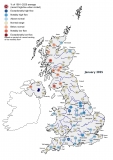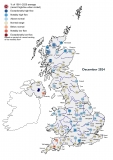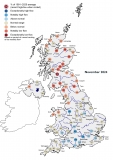In contrast to rainfall, river flow records are generally short, the average record length for gauging stations on the NRFA is around 40 years. Correspondingly, lengthy time series assume a particularly importance, providing an essential context within which to examine contemporary hydrological variability. There are ~370 stations with daily flow records exceeding 50 years on the NRFA and ~40 which exceed 70 years. The longest continuous time series, those for the Thames and Lee extend back to the 1880s and, importantly, they comprise both gauged and naturalised flows; the latter take account of the major abstractions upstream of the gauging stations. The significance of the latter may be appreciated by noting that in a dry year, more than half of the Thames flows may be abstracted to meet London’s water needs. Routine flow naturalisation is undertaken for only a small minority of UK river flow records.
The daily time series which constitute the core of the NRFA are complemented by less formal, and often discontinuous datasets, river (or spring) flow datasets which help provide a longer historical perspective against which to compare contemporary hydrological conditions. The earliest extant monitoring station is at Wendover Wharf (now operated by the Canal & River Trust). Contemporary daily flow data are complemented by monthly flow records for the 1841-1897 period; these provide a unique insight into spring runoff patterns throughout the Victorian era.
The NRFA would welcome additional lengthy and/or historical river flow series (supported, if possible, by details of their provenance) to help provide a fuller understanding of runoff variability prior to the modern era.
Click here to access the NRFA Long Records Initiative pages.



